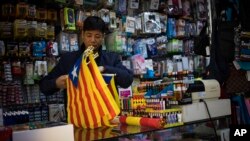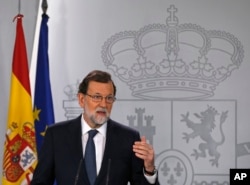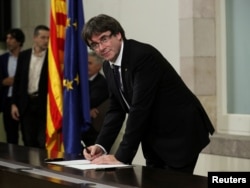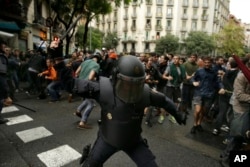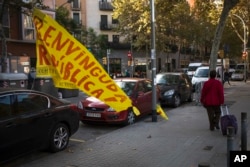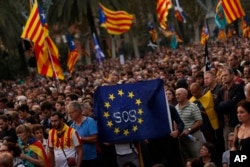Spanish Prime Minister Mariano Rajoy Wednesday appeared poised to suspend the semi-autonomy of the country’s restive northeast region of Catalonia and close its parliament in a move that risks triggering civil unrest, deepening Spain’s worst political crisis since a failed coup four decades ago.
The Spanish leader, who heads a center-right national government, asked Catalan secessionists for clarification on their announcement Tuesday that they had earned the right to declare a breakaway state, but were suspending implementing independence, pending negotiations with Madrid.
Independence or not?
In televised remarks, Rajoy formally demanded that Catalan’s leader, Carles Puigdemont, clarify whether he has declared independence, saying that is needed before the Spanish government can decide what steps to take.
And in what is being seen as a thinly veiled threat, Rajoy said clarity was required for him to be able to invoke the power to suspend Catalonia’s semi-autonomy and move to rule the region directly from Madrid under Article 155 of Spain’s constitution.
“This call - ahead of any of the measures that the government may adopt under Article 155 of our constitution - seeks to offer citizens the clarity and security that a question of such importance requires,” Rajoy said.
“There is an urgent need to put an end to the situation that Catalonia is going through - to return it to safety, tranquillity and calm and to do that as quickly as possible,” he added.
In a combative speech before the Spanish parliament later Wednesday, Rajoy told national lawmakers that the October 1 referendum in Catalonia was a “farce.” Rajoy gave no indication that Madrid was prepared to negotiate anything with the secessionists in the Catalan capital. “We have to put a halt to this slippage,” he said, adding, his “ultimate objective is to recover stability.”
On Tuesday, as Catalonia’s regional legislature met to discuss whether to declare independence, national police units, deployed initially in the region to try to halt the recent October 1 independence referendum, reinforced their positions at transport hubs, including the international airport and mainline railway stations.
Rajoy faces pressure from his own Partido Popular (People’s Party) to maintain a hardline with the separatists. Rajoy issued his demand following a special Cabinet meeting called to shape Madrid’s response to Tuesday’s announcement from Puigdemont that he was proceeding with an independence declaration, but suspending implementation to facilitate negotiations.
On Tuesday night, Puigdemont signed a self-rule declaration after delivering a rambling 40-minute speech in the Catalan parliament. Rajoy accused the Catalan leader of engaging in an exercise of “deliberate confusion,” one that was intended, Madrid believes, to reduce the possibility of Rajoy invoking Article 155.
That article allows the central government to take control of an autonomous region, if it fails to “fulfill the obligations imposed upon it by the constitution or other laws, or acts in a way that is seriously prejudicial to the general interest of Spain.” It has never been invoked before and is seen as a "nuclear option," or extreme response.
The Spanish Senate has started preparations to trigger Article 155, but the legal process will not begin until the Catalan leadership has responded, say Spanish officials.
Fear of violence
With tempers running high in the region, closing the Catalan parliament and presumably arresting secessionist leaders risks catapulting the crisis along more violent lines, fear some analysts.
Catalan separatists remain furious at the actions of Spanish national police and Guardia Civil when they sought to disrupt the independence referendum, which saw officers raiding polling stations, beating voters and firing rubber bullets at crowds.
The Catalan leader on Tuesday night pulled back from declaring immediate independence, instead calling for more dialogue with Spain in a bid to resolve the situation peacefully. His speech, however, was ambiguous.
Some Catalan secessionists are angry with Puigdemont for not opting for an immediate break with Spain. Members of the far-left Popular Unity Candidacy, whose 10 regional lawmakers make up part of a pro-independence majority in the Catalan parliament, urged him to honor the recent referendum, in which more than 90 percent of voters backed secession. They have warned they may break with the governing coalition in the regional parliament if they think he is reneging on his independence pledge.
Arran, the anti-capitalist direct action group that carried out arson attacks on tourist sites in August, accused Puigdemont of “inadmissible treason.” On Tuesday night, many among the pro-independence crowd waiting outside the Catalan parliament also expressed dismay that Puigdemont had not declared immediate self-rule, and some booed the 54-year-old former journalist when he left the building.
The Catalan leader, who commands only a slim majority in the Catalan parliament, had come under intense pressure from moderates in his ranks to try to avoid giving Madrid reasons to announce direct rule. They appear to be putting their hopes on international mediation and have pressed European leaders to intervene, something Paris, Berlin and Brussels have said they will not do.
European appeal
European Commission President Donald Tusk called on Puigdemont not to divide Spain, but also urged restraint on Madrid. Tusk said he had asked “Prime Minister Rajoy to look for a solution to the problem without the use of force. To look for dialogue. Because the force of arguments is always better than the argument of force.”
Speaking later Wednesday, Pedro Sanchez, leader of Spain’s opposition socialist party, urged Puigdemont to “be black-and-white” about whether independence had been declared. If it has, he said, his party would back any action the national government decides on to maintain Spain’s unity.
But he offered a possible exit from further confrontation between Madrid and Barcelona, saying Rajoy had agreed that there should be a six-month commission to examine the possibility of reforming the country’s constitution, changing the way the country’s autonomous regions are governed.




